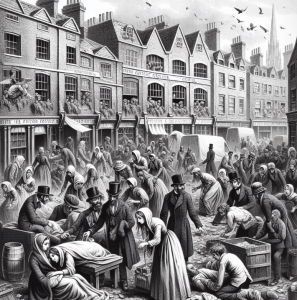Industrial Revolution (1800’s-1940’s)
42 The Public Health Act In England
Jenna Ramunno and Grace Gardner
Introduction
During the Industrial Revolution in England, there was a quick demand for housing an abundance of workers near factories. This led to the rapid growth of urbanization resulting in poorly constructed houses with little to no space. Houses were made without technology such as proper sewage and fresh-water. Living in such poor conditions, major diseases would spread quickly endangering a lot of England’s population. This started to concern much of the English society as diseases were not only spreading and wiping out the working class, who lived in the inner cities but also affected the middle class.
With the sudden rise and growth of urbanization in England, there was also a rise in concern for diseases that were rapidly spreading and taking the lives of many English residents. During the 1800’s they did not have any of the right knowledge for vaccines or to cure any of the deadly diseases spreading through England. Without this knowledge, they could not cure the victims of these illnesses. The infant death rate was over 50% and the national crude death rate was 23 per 1000. (Brown & Fee, 2005). The English society had a big problem on their hands and the only proactive thing they could do was try to prevent or contain the breakouts.

During this time, society came to the observation that a lot of the diseases were concentrated around the lower working class. With the neglect of their homes and living conditions the air was easily contaminated and deadly disease outbreaks spread quickly. The society of England came to the conclusion of making a Public Health Act. With limited knowledge on medication during the 1800’s, the Public Health Act provided new urban sanitation regulations and structures in efforts to stop and contain the spread of fatal diseases that threatened the society of England.
Acknowledgment for the Need of Public Health
Edwin Chadwick
There were several factors that led to the realization that society had a big problem on their hands. Edwin Chadwick was a

propagandist and was best-known for attracting people’s attention to sanitary and health issues. He worked as a journalist in England who documented the life of the poor and observed the sanitary conditions in the area. He became interested in public health when he joined as a junior member of the 1832 royal commission on the poor law. (Hamlin & Sidley, 1998). He also wrote several journal entries including “Report on the Sanitary Condition of the Laboring Population of Great Britain” and “Health of Towns Association” to attract public attention. (Brown, 1970). In these journal entries, he brought attention to society about the lack of sanitation and its relation to the life of the working class. (1842 Report on the Sanitary Condition of the Laboring Population of Great Britain).
Society
Society in England during the 1800s was split into two groups, the working class and the middle class, because of the great difference in wealth. Compared to the wealthier middle class, the working class was treated very poorly. For example, water companies and builders wanted to make a profit. Therefore, they would only supply water and construction to those areas of town where the middle class lived because they could afford it. They ignored the working class’s need for cheap housing and paid little attention to their house’s drainage, ventilation, or need for clean water. Private landlords for the working class’s houses also neglected the responsibility to pay for sanitary improvements and the cleanliness of their homes because of the cost. (Brown, 1970). The neglect of the working class and their living arrangements contaminated the air which led to the spread of diseases. (Hamlin & Sidley, 1998). In addition, middle-class houses were built on the edge of town so they were far apart from the urban slums where all these problems were located. (Brown, 1970). However, they soon learned that the distance was not enough and the contaminated air affected all of England’s society.
Cholera Outbreak
From 1832-1848, the disease cholera hit and affected a great deal of the population in England. Although cholera was concentrated on the working class because of their lack of sanitization, it was also responsible for the deaths of many families in the middle class. It drew attention to the working class as they were blamed for the disease. In addition, it brought awareness to the relationship between the disease and the working class. The disease was concentrated around the society of the poorest districts where sanitation was the most neglected. (Brown & Fee, 2005). Cholera spread so quickly because of how close the housing was in the city. Furthermore, the disease also contaminated the air quality which let it spread to the neighboring towns where the middle class lived. The society of England soon realized that with the rapid spread of cholera from the poor slums of the working class to the homes of the wealthy, there was a great need for sanitary reform. This led to the first Public Health Act of 1848. The Act was a direct governmental response to the widespread devastation caused by cholera, marking a shift toward more proactive public health policies aimed at protecting all social classes. This legislative response laid the foundation for future reforms and signaled the beginning of a new era in urban health management.
The Public Health Act of 1848
The Public Health Act of 1848 was a response to the social and health problems generated by the industrial revolution. However, it only gave the broadest suggestion about what public policies would actually accomplish these problems. There were only local efforts to build sewers, bring in fresh-water, regulate buildings, remove waste, etc. Society was brought together but towns could not fulfill these efforts and could only provide partial services because of the lack of money and resources. (Hamlin & Sidley, 1998). Therefore, the Public Health Act did not fix the problems society was facing at this time. It was a gap between acknowledging the problem and solving it, but also was a catalyst for the development of a local government and their responsibility for public health. (Brown & Fee, 2005).
For example, the chart below demonstrates the death rate in certain years after the Public Health Act of 1848. As one can tell, the chart demonstrates how the death rate decreased in certain years after 1848 but did not have an overall big impact or long term effect. With concerns still high and little change, The Public Health Act of 1875 was created. (Calkins, 1891).
Figure 2: Average Annual Mortality Rate
| Year | Rate | Year | Rate |
| 1866 | 23.4 | 1871 | 22.6 |
| 1867 | 21.7 | 1872 | 21.3 |
| 1868 | 21.8 | 1873 | 21.0 |
| 1869 | 22.3 | 1874 | 22.2 |
| 1870 | 22.9 | 1875 | 22.7 |
(Caulkins, 1891, p. 297)
The Public Health Act of 1875
Overall, the Public Health Act of 1875 consolidated public health legislation and brought some uniformity to its administration. To have more control, the administration divided the entire country into urban and rural sanitary districts. Each was given a local health authority and a medical officer of health. (Brown & Fee,2005). The regulations that were suggested in the Public Health Act of 1848 became enforced. Therefore, the force of local authorities did not act to improve water supply, sewage systems, or other sanitation to urban and rural areas until 1875. (Brown, 1970).
The Public Health Act of 1875 printed a specified number list with regulations to uphold and what group is in charge of each. This includes regulations of districts and authorities, sewage and drainage and highways and streets. For example, local government provisions are in charge of highways and streets. They are responsible for highways, regulation of streets and buildings, lighting streets, public pleasure grounds, markets and slaughter-houses, and police regulations. (Public Health Act, 1875).
*Click link below to see ch.55 of the Public Health Act, including full list of regulations and more.
Public Health Act of 1875: Ch. 55
Conclusion
Ultimately, the Public Health Act marked a transformative step in reshaping both public policy and societal attitudes toward hygiene in 19th-century England. At a time when medical knowledge was limited and cures for many deadly diseases were nonexistent, the primary method of disease prevention was containment and environmental reform. The Act aimed to address the unsanitary living conditions that facilitated the rapid spread of illness, especially in densely populated urban areas. This initiative required cooperation between the working and middle classes, who together undertook the immense task of improving urban infrastructure—cleaning slums, securing clean water supplies, and establishing effective sewage systems. By 1890, the financial investment in sanitary reform was estimated at approximately $583,500,000 (Calkins, 1891), reflecting both the scale and seriousness of the endeavor. While there was initial uncertainty surrounding the overall effectiveness of the Public Health Act, it nonetheless represented one of the first significant public efforts to prioritize health and sanitation as essential components of civic life. In conclusion, despite the limited medical advancements of the era, the Public Health Act laid the groundwork for modern public health policies by instituting foundational urban sanitation measures aimed at curbing the devastating impact of disease across England.
Chapter Questions
- Short Answer: Name at least three of the sanitary provision changes authorities were obligated to make because of the Public Health Act?
- Short Response: How did the cholera outbreaks in England influence the development and implementation of the Public Health Act?
- Short Response: Overall do you think the changes from the Public Health Act were enough to prevent dangerous diseases and infections like cholera?
- Multiple Choice: The Public Health Act mainly affected which living area the most?
A) Urban
B) Rural
C) Suburban
D) All of the above
References:
Brown, T.M., & Fee, E. (2005). Public Health Classics: The Public Health Act of 1848. Retrieved from
https://www.who.int/bulletin/volumes/83/11/866.pdf?ua=1
Brown, R. (1970, January 1). Public Health 1832-1854. Retrieved from http://richardjohnbr.blogspot.com/2008/04/public-health-1832-1854.html
Calkins, G. N. (1891). Some results of sanitary legislation in England since 1875. Publications of the American Statistical Association, 2(14), 297-303. Retrieved from: https://www-jstor-org.libproxy.clemson.edu/stable/2276577
Hamlin, C., & Sidley, P. (1998). Revolutions in public health: 1848, and 1998?. Bmj, 317(7158), 587-591.
Krieger, N., & Birn, A. E. (1998). A vision of social justice as the foundation of public health: commemorating 150 years of the spirit of 1848. American Journal of Public Health, 88(11), 1603-1606.
Murphy, N. (2022). Plague hospitals and poor relief in late medieval and early modern France. Social History, 47(4), 349–371. https://doi-org.libproxy.clemson.edu/10.1080/03071022.2022.2112859
Petersen, A., & Lupton, D. (1996). The new public health: Health and self in the age of risk. Sage Publications, Inc.
Public Health Act 1875. (n.d.). Retrieved from
https://navigator.health.org.uk/content/publichealth-act1875
Reports from Commissions: Sanitary Condition of the Labouring Population of Great Britain.(1842). Retrieved from https://www.parliament.uk/about/living-heritage/transformingsociety/livinglearning/coll-9-health1/health-02/
Figures:
“Sir Edwin Chadwick” by T.h.i.b.a.u.l.t. is licensed under CC BY 4.0
Resource Links to Look Further Into

